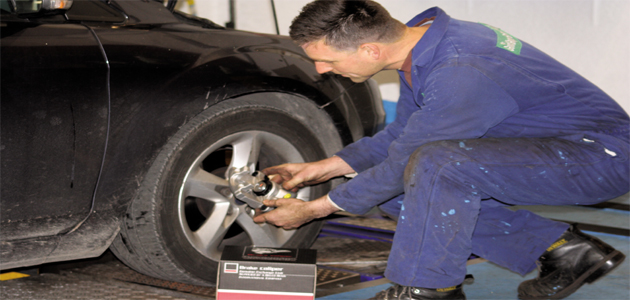
With the continuing move by VMs to fit more electronics on today’s vehicles, it has been no surprise that we’re seeing more electrics increasingly being added to braking systems.
The heightened emphasis on automotive safety and convenience, together with the ever-growing concerns over emissions has bolstered the adoption of Electric Park Brake (EPB) systems in passenger cars.
In fact, analysis from a leading business consultant shows the market for EPBs ‘surging’ following their commercial launch in 2010.
The purpose of this article, therefore, is to focus on the two different EPB systems – the cable puller system and the electric motor on caliper system.

The cable puller system
The handbrake lever is replaced by an electric switch. An actuator – in this case a device, which transforms an electric input signal into motion – is pulling and releasing the cables from the handbrake mechanism on the rear caliper. The advantage of this system is that it can be fitted to any vehicle being built today and it can be used both on disc and drum brakes. Ford uses the cable puller system on the C-Max and S-Max while other vehicles using this technology are Renault (Scenic), Citroen (C5), Peugeot (3008) and Range Rover.
Electric motor on caliper system
This is a system which utilises a small electric motor that is mounted directly on the caliper. This motor can then move the piston of the rear caliper to lock and unlock the parking brake function. There are no cables used and no handbrake lever; instead the lever is replaced by an electric switch. Additionally the system will only work with disc brakes. VW Group – VW and Audi (Passat, Sharan, Tiguan, A4, A5, A6, A8, Q3, Q5) – and recently Seat (on the new shape 2010 Alhambra) are all using the EPB with electric motor on the caliper.
System advantages
The EPB is just one step to an entirely electrical brake system and has several clear advantages. It offers a more spacious centre console and can provide additional brake power on all four wheels during hazardous driving conditions. A conventional parking brake works less well when the brakes are hot, yet EPBs will automatically adjust.
Cable puller EPB systems can automatically adjust the length of the bowden cable when the pads are worn and the ‘Auto Hold‘ function means the parking brake is applied, even when the car is at idle.
Latest technology
Fully integrated EPB calipers now involve four-way communication through the ECU. This allows the wheels to brake independently via the electronic circuit, giving the driver much more control over the braking. The newest integrated EPB calipers are being fitted on the Audi A8, as they currently tend only to be fitted on the top end vehicles. What we often see, however, is that this technology soon migrates to lower end vehicles.
Quicker for the technician
When changing the EPB, the installer doesn’t have to worry about all the cabling going from one end of the car. This makes them quicker to replace, as the technician also does not have to worry about replacing brake cables.









